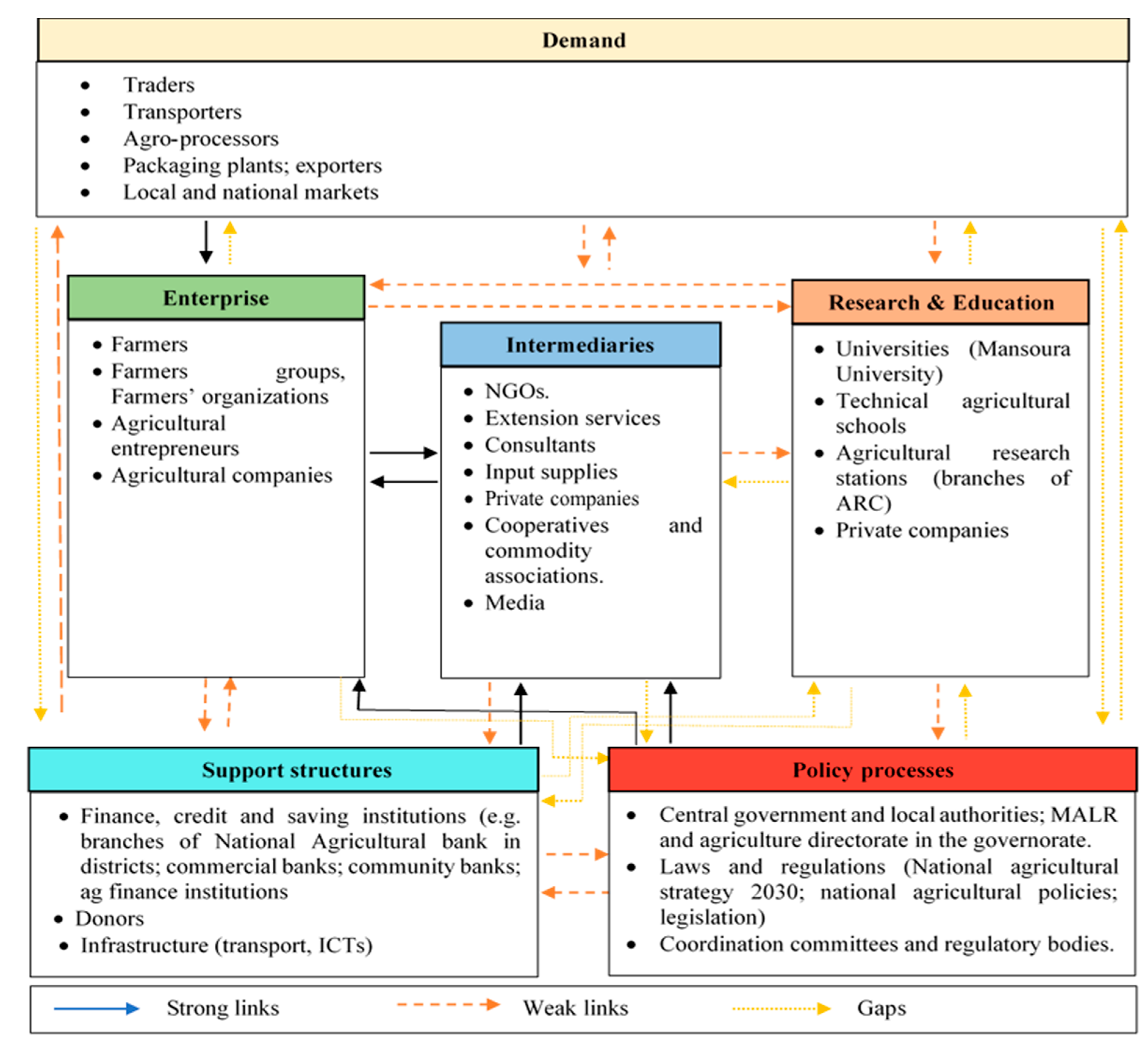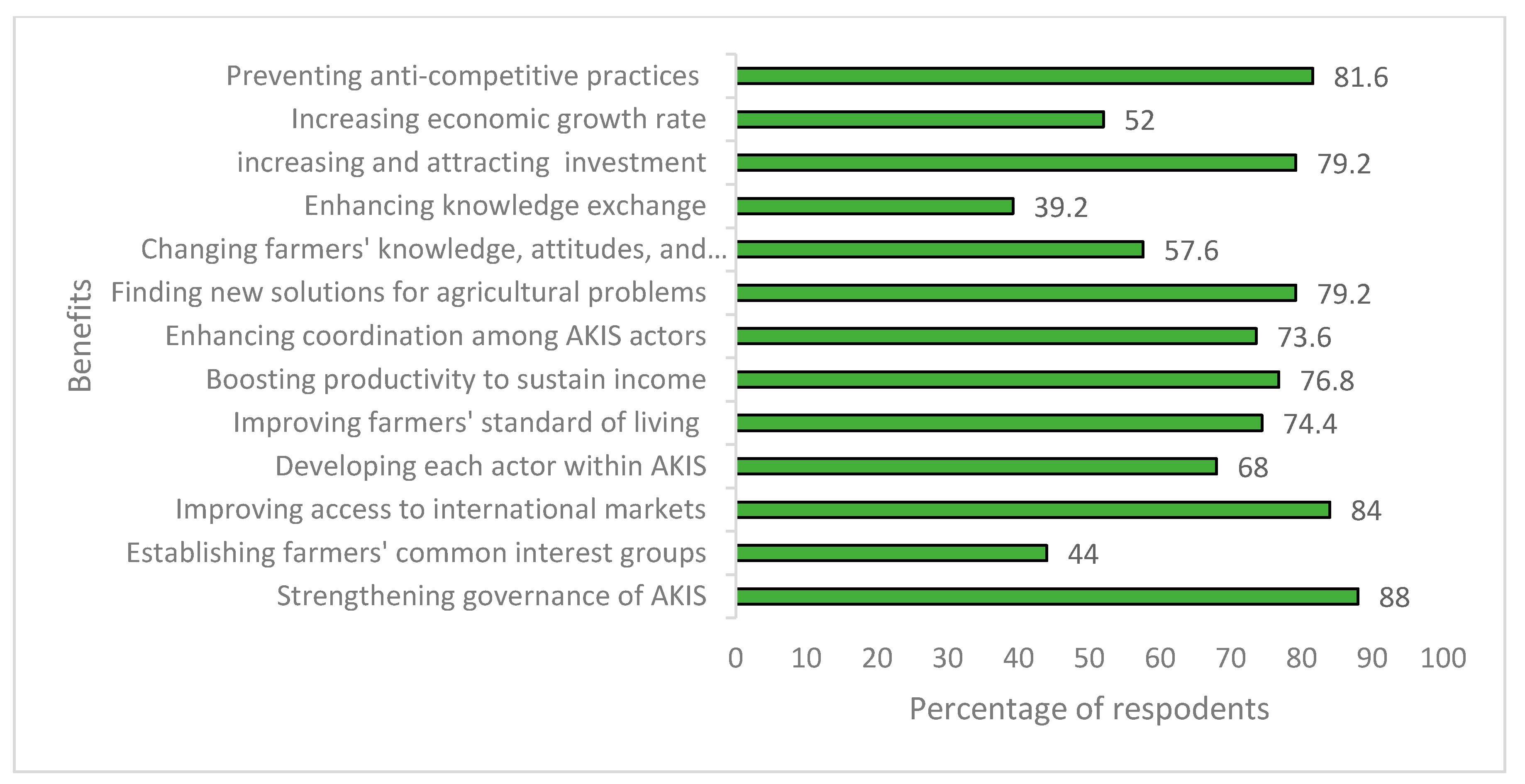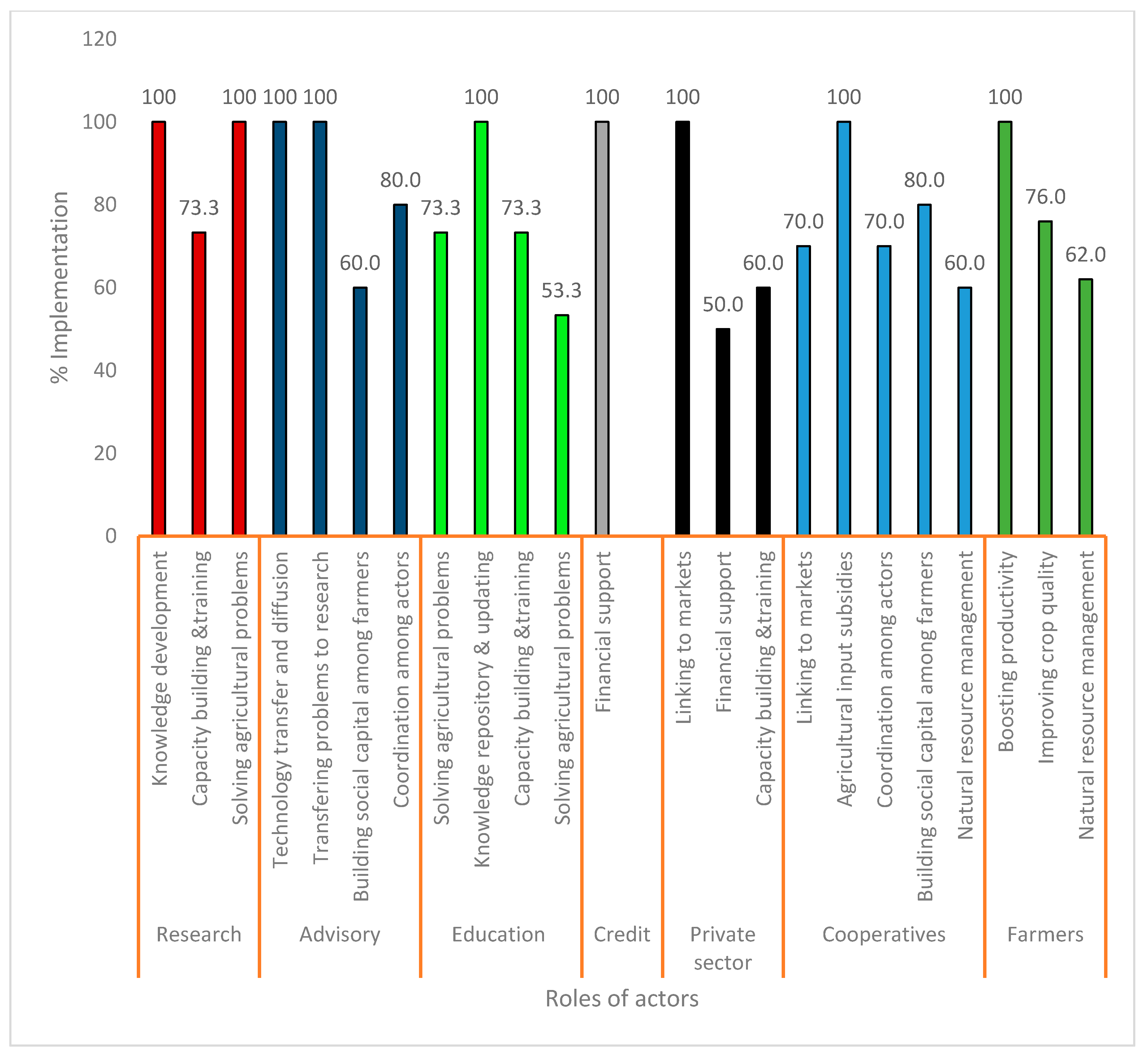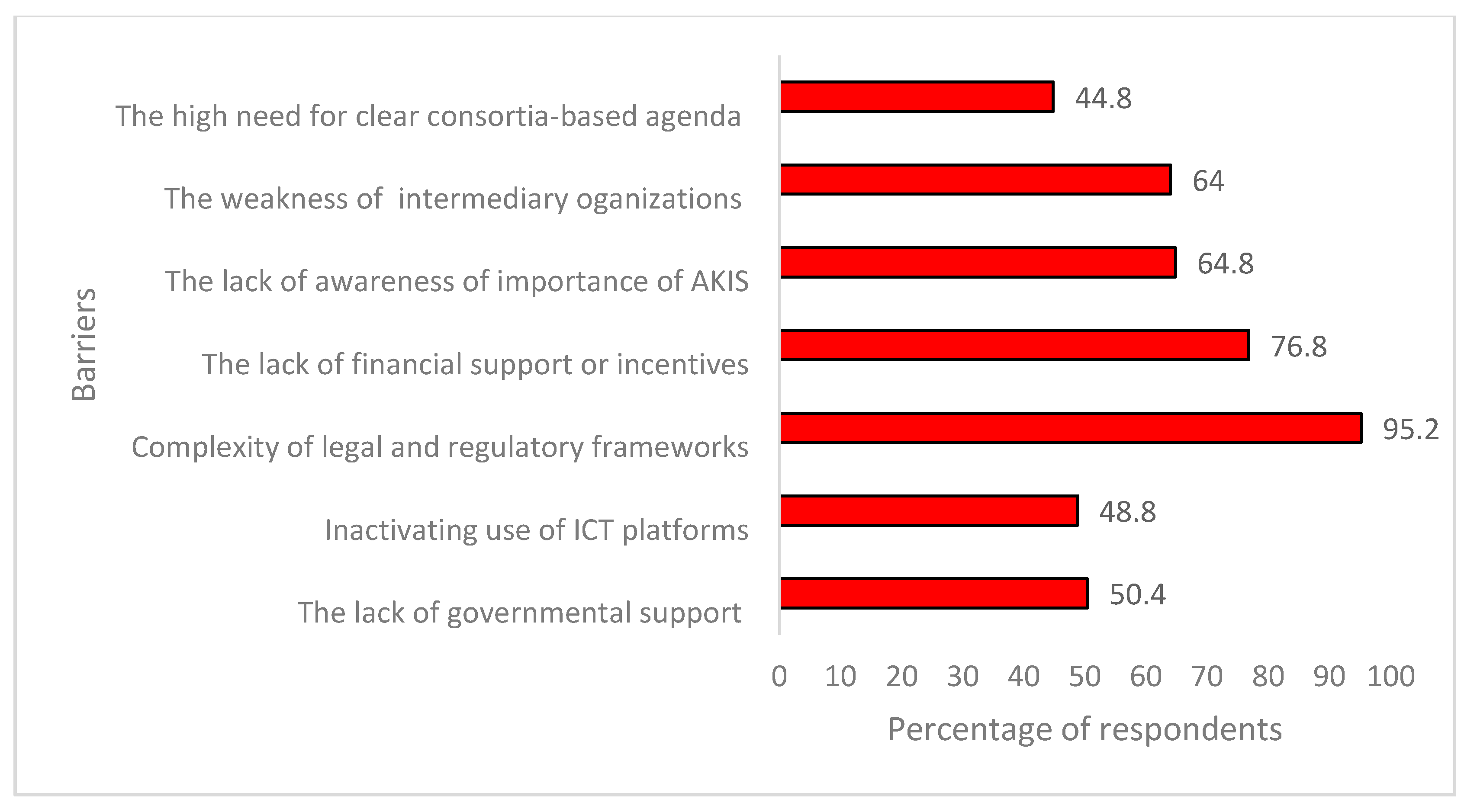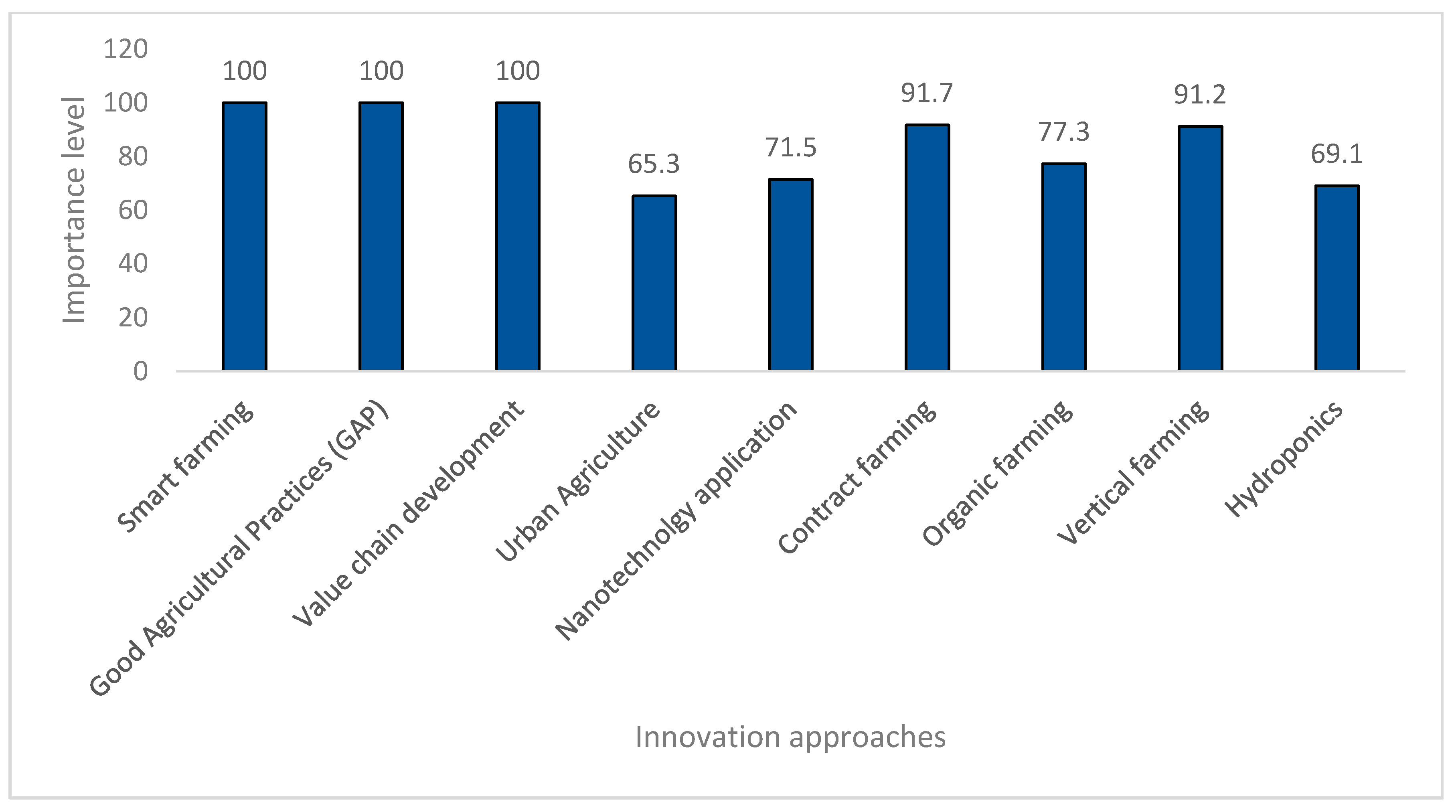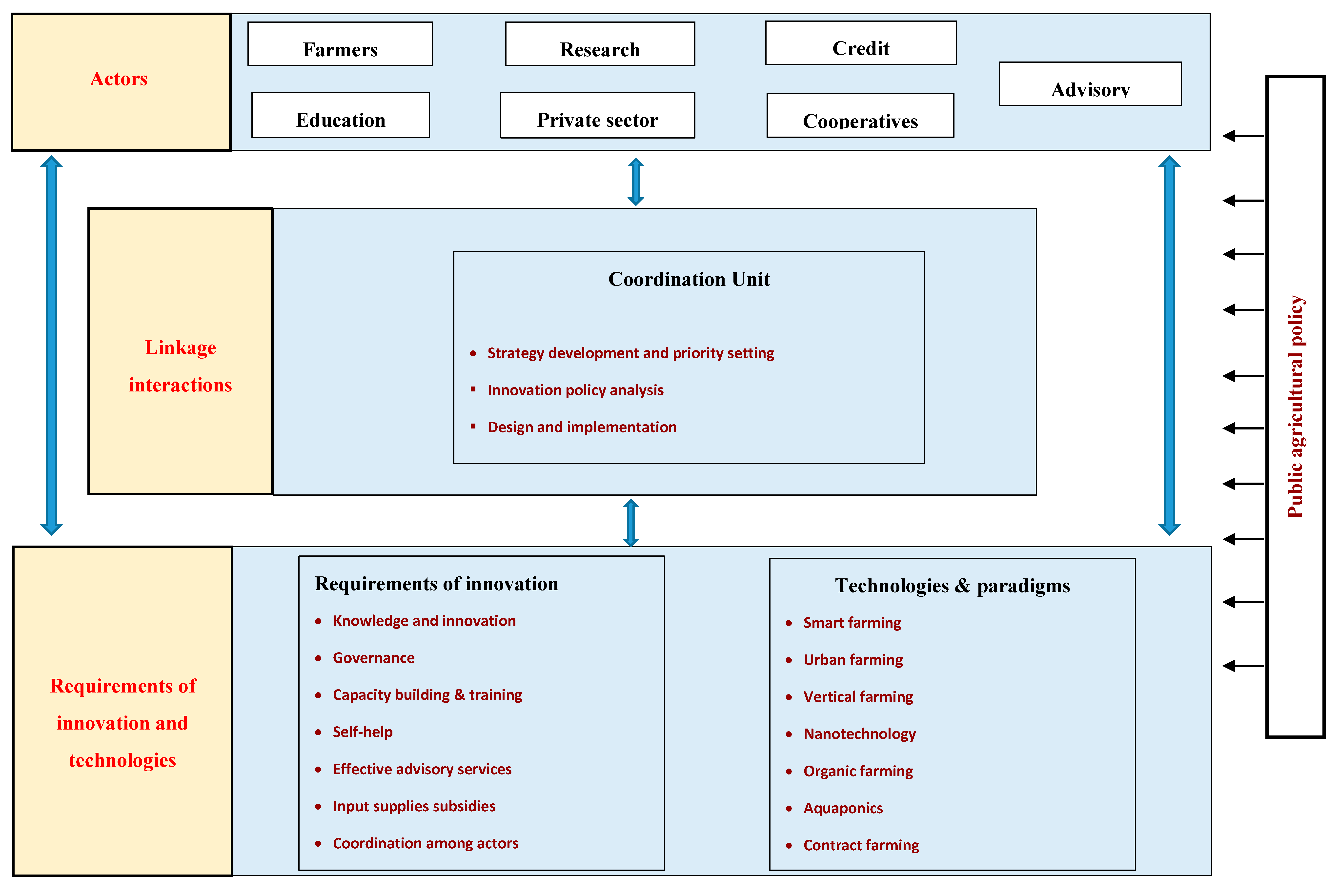1. Introduction
To meet the increasing demand of food and to respond to new market opportunities, agricultural systems worldwide need to be more sustainable by generating and applying new knowledge and innovations [
1]. Innovation is seen as one of the main drivers of productivity, self-sufficiency, competitiveness, and profitability, and at the same time, a tool to ensure environmental sustainability [
2,
3]. Despite this, there is evidence that innovations are not widely adopted at scale, and the agricultural systems are not reaching its full potential in terms of innovation due to the approach adopted in managing resources, socioeconomic concerns, and policy regulations and measures [
4,
5]. This lack of innovation in agriculture has led to the question of how the agricultural innovations are developed, spread, organized, and how the quality and relevance of these processes can be enhanced [
6,
7].
Historically, the framework that describes the process of knowledge generation and use in agriculture was dominated by a linear model (transfer of technology approach) [
8]. This approach operated under the assumption that technology is developed by scientists, then extension services diffuse these innovations among farmers. This concept was further developed to agricultural knowledge system to illustrate the interactions of research, extension, and education with farmers [
9,
10]. With the need for rural competitiveness to allow agricultural systems to remain competitive in a changing socioeconomic environment, the concept of agricultural innovation system (AIS) was merged to reflect the importance of going beyond the creation of knowledge and highlights that innovation systems are social systems [
11]. This thinking was developed over time toward promotion of agricultural system multifunctionality by supporting collective and integrated processes of multi-actors to co-produce innovations through interactions among all stakeholders in the agri-food chain [
3]. Recently, the conceptualization of agricultural innovation systems to better support sustainability is called agricultural knowledge and innovation system (AKIS) [
4,
12]. According to EU [
13], moving from the linear model of knowledge to AKIS is attributed to four drivers: Disconnection between farmers’ indigenous knowledge, extension, and research; increasing concern for adverse environmental impacts associated with industrial agriculture in the policy agenda; multifunctional agriculture requires coordination and integration among different stakeholders; and restructuring reforms that have been implemented in research, extension, and education institutions.
The AKIS framework has been embedded in the policy agenda of many countries to explore and analyze solutions of complex agricultural problems [
12,
14,
15,
16,
17]. AKIS is broadly defined as a network of individuals, enterprises, and organizations focused on developing innovations with regard to new products, new processes, and new forms of organization into economic use, together with policies and institutions that facilitate the way different stakeholders interact, access, share, exchange, and use knowledge [
12,
15]. This framework includes three essential elements: (a) A knowledge and education domain; (b) a business and enterprise domain; and (c) linkages between institutions that link the two domains [
3].
According to Hermans et al. [
18], a well-developed AKIS has seven main functions, including guidance of search, knowledge development, network formation and knowledge diffusion, entrepreneurial activities, market formation, resource mobilization, and creation of legitimacy and counteracting resistance to change. Therefore, it is important to diagnose AKIS at the level of a country, a sector, or a particular technology [
15]. Such analysis is important to understand the constraints to innovation and technological change, role of innovation policies, and support structures and the governance of actor interactions in innovation [
12,
15].
In Egypt, the AKIS has three main domains: Research and education: Agricultural Research Center (ARC), Desert Research Center, universities, and vocational agricultural schools; intermediaries: The Central Administration of Agricultural Extension Services and its local branches (extension centers), private sectors, cooperatives, non-government organizations (NGOs); business and enterprise: Farmers, agricultural companies, traders, and other stakeholders in the agricultural value chain [
19]. Different studies examined the structure dimensions of AKIS in Egypt and reached to number of problems and challenges that inhibit its efficiency and effectiveness in supporting innovation and sustainability to the agricultural sector. These problems include: Fragmentation and dominance of overall “technology transfer logics,” lack of laboratory and research capability of research and development actors, weak interaction linkages among actors, trust among beneficiaries in scientific research results, absence of knowledge utilization initiative of university policy planners, absence of clear national plans for benefiting from agricultural innovations, and ineffective extension services [
20,
21,
22,
23,
24,
25]. These problems in AKIS has translated into a generally weak innovation system in Egypt. To address such problems, the objective of our empirical study is to develop a framework of AKIS at a regional level (Dakhalia governorate). This analysis may be useful to enhance the overall performance of AKIS in the study area.
3. Methodology
This study was carried out in the Dakahalia governorate in the northeast region of Egypt. The governorate has a total area of 3500 km² and a population of approximately 6 million, where an estimated 71.8% live in rural areas. The governorate is considered to have a desert climate. The average annual temperature is 20.5 °C, and it receives an average 56 mm annual rainfall. March and April are the wettest, whereas June, July, and August are the hottest months of the region. The governorate is divided into 22 districts, with 37% of the total area cultivated. The majority of crops is grown under a surface irrigation system from a network of canals and channels of the River Nile. Rice, wheat, corn, Egyptian clover, Sugar beet, vegetables, and citrus fruits represent the major cropping pattern in the governorate [
38]. This governorate was selected as a site for the present study, as it considered the largest governorate in terms of total agricultural land in the country (approximately 8.3%), as well as characterized by agricultural production diversity [
39]. Moreover, the geographic proximity of this governorate to the research team facilitated good communication and collection of needed information.
The population of study consists of the employers in all actors of the DG-AKIS in the governorate. Seven actors (research, advisory, education, private sector, credit, farmers, and cooperatives) involved in different activities of the DG-AKIS were included in the study. Sampling was done separately for each of the different actors. Data were collected from the randomly sampled 125 representatives of all actors as follows: 15 researchers from research stations, 15 faculty members from the Faculty of Agriculture of Mansoura University, 15 directors of extension centers and heads of agricultural extension departments at the directorates, 10 headquarters of agricultural cooperatives, 10 representatives of head quarter of agricultural companies, 10 directors of agricultural bank branches, and 50 farmers. Prior to data collection, a pilot survey was conducted involving 5 representatives from each actor in the study area. The authors revised several statements to suit the results of the pre-test and objectives of this study. Consequently, the instrument was modified to its final version for data collection through face-to-face interviews during January–March 2019.
To analyze the existing situation of DG-AKIS, the questionnaire consisted of five sections to examine the three structural dimensions under investigation; actors (
Section 1,
Section 2 and
Section 3), interactions (
Section 4), and technologies (
Section 5). The first section included the actors’ acceptance level of developing the DG-AKIS. In this part, actors were asked to identify the importance level of developing the AKIS on a 5-point Likert scale ranged from 5 (very important) to 1 (not important at all). Furthermore, Actors were asked an open question about the benefits gained from strengthening the DG-AKIS. The second section included the functions of actors within the DG-AKIS. In this section, we formed an open question to illustrate the potential roles of each actor within the DG-AKIS. The third section consisted of barriers to DG-AKIS development. These barriers were mentioned from the actors’ point of view by asking an open question. The fourth section included the interaction linkages based on literature review. In this section, the respondents were asked to identify each linkage’s importance level on a 5-point Likert scale ranged from 5 (very important) to 1 (not important at all). Moreover, each actor was asked to explore the current linkages with other actors. Section five comprises the requirements of sustainable agriculture and innovation approaches. These were concluded from international literature and the Egyptian strategic plan 2030 [
40]. In this section, surveyed actors were asked to identify the availability level of sustainable agriculture requirements in Egypt on a 5-point Likert scale ranged from 5 (very high) to 1 (very low). Furthermore, the respondents identified the importance of innovation approaches to Egyptian agriculture particularly at a governorate level, on a 5-point Likert scale ranged from 5 (very important) to 1 (not important at all). Finally, they were also made to express their views about the availability of sustainable agricultural requirements to each innovation approach.
We prepared the first draft of the suggested framework to strengthen the DG-AKIS after analyzing the findings of the questionnaire. This framework was reviewed during a focus group discussion, which was organized with 12 members who were previously invited to answer the questionnaire, having two representatives from each actor. The focus group discussion was facilitated by the first and third authors at Mansoura University. At the beginning of the discussion, a short presentation explaining the purpose of the meeting and findings of the first stage was introduced. Frequency, percentages, mean, and standard deviation were used to describe and present the results. Furthermore, relative weight (%) was calculated as follows [
41]:
(Pi = Each parameter amount; Wi = Each parameter weight; Wmax = the maximum weight that can belong to each parameter (2); and n = the number of each factor parameters).
5. Conclusions
The present study offers new insights for strengthening the interaction linkages within regional AKIS in Egypt, as perceived by a range of actors, such as farmers, cooperatives, research, advisory, credit, education, and private sector. The contribution of this paper is two-fold; first, providing insights into the functioning of a regional AKIS. Second, it deepens the literature on structural–functional innovation systems analysis by suggesting a framework that illustrates how regional dimensions, coupled with structural elements, could enhance the functioning of a regional AKIS. The multi-actor approach used in this study allowed us to obtain information on innovation processes that was relevant to diverse actors and structural dimensions of the system. Results indicated that the actors had a positive view toward developing the DG-AKIS. Potential roles mentioned by the actors to strengthen this system confirm three main points; upgrading the DG-AKIS ensures benefits for all actors, tasks specificity ensures efficient and effective performance of roles and tasks, and weak points in each actor could be complemented by strong points of other actors. Actors also perceived a broad range of barriers to development. Partially, these barriers could be overcome by a better design of linkage interactions between the actors, capacity building of actors in terms of the innovation requirements in the agricultural sector, and adoption of new emerging technologies. It was also concluded that PPPs are the most suitable interaction linkage from the actors’ point of view. These partnerships could be effective between partners if it well prepared in a formal way and the local government implements the solidarity mechanism in case of conflicts. The current level of the requirements of sustainable agriculture in each innovation approach identified by the actors reflects the gaps that should be taken into account to formulate capacity building strategies for supporting innovation processes within the DG-AKIS. The findings of the focus group discussion confirm that coordination in innovation systems relies on governance. In other words, there is a need for a coordination unit in the DG-AKIS. This unit could enhance the policy coordination, which is concerned the determination of priorities, the development of a clear, consistent, and agreed set of policies, and putting these policies into practice. Furthermore, supporting administrative coordination, which concerns the problem of synergy and complementarity among actors. Consequently, the outcome of coordination unit could be seen in different ways such as increase the efficiency of funding in the short term, manage the issues related to agricultural innovation, and integrating institutions. The study also revealed that the proposed framework can be used as a tool to link functions to the structure of an innovation system. This framework can be empirically implemented to enhance the synergy and complementarity among the AKIS actors. To achieve that, the study recommends some essential procedures that should be implemented, including collecting data at all levels of the suggested framework, improving the availability of a conducive environment in achieving the principles of synergy and complementarity among actors, formalizing a contract form regarding each linkage mechanism, testing this format in a specific geographical area, and summarizing the learned lessons. Further research is recommended to assess and analyze whether innovation processes are affected by the scale of the different infrastructural dimensions (research and development, financial, or physical) of actors.
